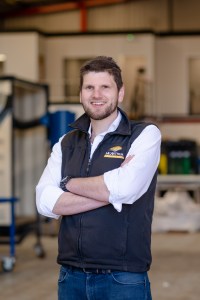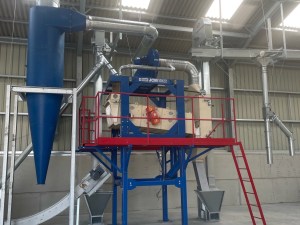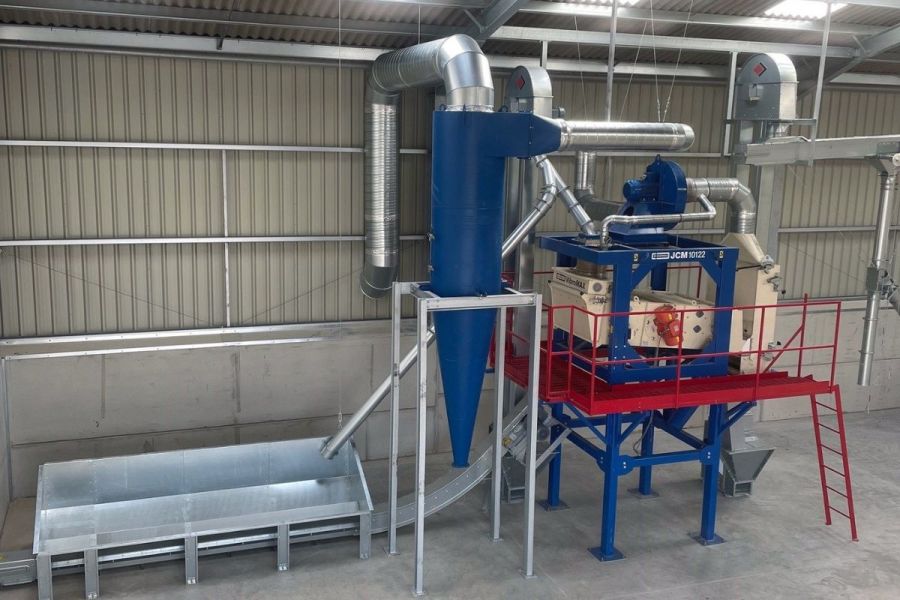A resurgence in the popularity of on-farm sieve cleaners is being driven by growers exploring intercropping, as well as those looking to clean grain to meet specification or wanting to home-save seed. CPM gets the low-down on what these machines can do.
“Even with paying the royalties, it’s saved us £12,000 in a year.”
By Melanie Jenkins
As the popularity of intercropping increases, many growers may find themselves using antiquated or makeshift equipment to clean and separate different crops, but a solution is available in the form of vibrating sieve cleaners.

According to John McArthur, there’s a movement back towards on-farm cleaning with a view to adding value post-harvest.
According to John McArthur of McArthur Agriculture, until the 1970s a grain cleaner, grader, scalper or pre-cleaner was a standard piece of equipment on any farm with a grain drier. “But as combines have improved, it’s been possible to get a better sample from the field which has removed the requirement for some cleaners.
“But now we’re seeing a movement back towards on-farm cleaning, with a view to adding value post-harvest,” he explains. “And where growers are adopting intercropping, this is also driving the market for cleaners and separators, as well as the interest in reducing seed costs which is prompting growers to clean their own farm saved seed. Further to this, some regen farmers believe untreated seed is more environmentally benign, benefits the soil microbiome and delivers better results.”
McArthur offers two JK Machinery sieve cleaners, the larger JCM VibroMax and the smaller JCC VibroCompact. “The former can fine-clean combinable crops at capacities ranging from 6-45t/hr, with grain moving across two or three tiers of vibrating sieves which cleans and separates crops based on size and shape. Performance can be optimised by altering the angle of the machine and vibration frequency. Crops then enter an aspirator where they are further separated by weight and aerodynamic properties.”
The VibroCompact is capable of pre-cleaning at 15t/hr, and up to 5t/hr in finer detail. “It’s a relatively small, simple machine with two sieves and a single aspirator,” says John. “It’s popular with individual farms which are looking to experiment with separating intercrops or to clean oats or malting barley grain so that it hits specification, whereas the larger machine might suit share farming agreements or larger commercial scale operations.”

The JCM VibroMax can fine clean combinable crops at capacities ranging from 6-45t/hr, with grain moving across two or three tiers of vibrating sieves which cleans and separates crops based on size and shape.
Both machines have numerous sampling points to allow for monitoring of performance as they’re being used. The sieves come in a multitude of sizes and can be swapped out easily so they suit both the crop and the required specification, says John.
“What you might not realise until you start using machines like these, is how much variation there is in a heap of grain in terms of physical size and even colour,” he explains. “We often say that buying the equipment is only 50% of the job, the next part is learning to get the best from it – it’s not just a case of tipping the crop in one end and taking it out the other. Crop size and shape can change year-on-year and there’s even more variation with intercropping, but the level of separation and cleaning required will depend on the end market.”
Outlet aspirators are optional add-ons, but these are essentially part of the package, explains John. “Once grain has been sorted by size, the aspirator will remove dust and light material from it. These can be really sophisticated and complex, but the standard version is included with all VibroMax and VibroCompact cleaners.”
Growers can also choose to include optional inlet aspirators, adjustable channel aspirators and expansion chambers, he adds. “These are suited to those who are looking to achieve a very high standard of cleaning or are cleaning a lot of different crops and requiring a tight level of control. If you’re producing grass seed, for example, you’ll require more advanced aspirator options to get the desired level of cleaning and separation.”
John notes that separating and cleaning are the first process to any value-added cropping system. “This could even include processing hemp seed or spelt – so there’s real versatility in how it’s used, this will just come down to what each individual business is looking to achieve.”
Paying its way
Tom Jewers has only had the JK Machinery JCC VibroCompact on farm for the past year, but already the machine’s had wheat, spring barley, oilseed rape, linseed, phacelia, vetch, mustard, buckwheat and beans put through it, and has proved its worth time and again.
Farming at GD Jewers and Son, in Suffolk, Tom works with his semi-retired parents and his wife, plus a seasonal worker during harvest, meaning he’s only got a small team to work the 390ha of owned and contract farmed land.

Tom Jewers initially invested in a VibroCompact to help clean and separate cover crop and niche crop seed.
Like a lot of others, break crops have been proving an issue for Tom. “We used to grow vining peas and sugar beet but had issues with those so we moved to OSR and beans. But now we struggle to grow OSR because of rape winter stem weevil, and although the beans are okay, they don’t make a lot of money.”
Because of these issues, Tom discovered he could grow more niche crops for seed. “When patching up OSR with phacelia, buckwheat and vetch, we decided to run the combine over it and use the seed ourselves. But then I had a conversation with a seed merchant who said they’d buy it because Brexit and the Ukraine war had made it harder for them to get cover crop seed, especially mustard and sunflower.”
So two years ago he planted phacelia and buckwheat for seed, but these can’t be desiccated and have to be harvested green, meaning they’re therefore prone to composting overnight so have to be rapidly cooled and cleaned, explains Tom. “And the seed company doesn’t want it right away, so we had to be able to store it safely on farm which meant we started looking at cleaners. We don’t have a lot of space, so we wanted a small unit, manoeuvrable with a telehandler.”
Tom came across the VibroCompact at Cereals and bought one which was 40% funded by a Landscape Enterprise Networks grant. “But it’s not an expensive machine, and although we were going in blind in regard to how much we’d use it, even without the grant the machine would have paid for itself in the first year.
“The biggest saving is in being able to clean our own OSR, beans and barley and even with paying the royalties, it’s saved us £12,000 in a year,” he says.
“But we aren’t just using it for cleaning our seed and to help us store crops safely, it also helps us add value because everything we do that the seed company doesn’t have to makes our seed worth more.”
As well as phacelia and buckwheat, Tom has also grown vetch and mustard, using the latter as a trellis for the former to grow on so the vetch doesn’t go flat. “As the seeds are different sizes we used the VibroCompact to clean and separate them in one pass, then put them through for a secondary clean. We even got the mustard out as a bi-crop so it has value – it’s not the next money-making break crop but it hasn’t lost us any money.”
It’s very much been a case of ‘try it and see’ when it comes to sieve sizes. And one thing Tom has realised is that no matter how many sieves he has, he never seems to have enough. “McArthur have been brilliant with these, though. When we found we required a different size, they sent some for us to try and took away the ones which weren’t right.”
Tom has managed to run up to 8t/hr through the machine, but this can vary, such as with wheat, barley and beans which go through at about 4-5t/hr. “It helps us make better use of our labour and we can fit it in on down days where we aren’t combining, or in the mornings before we can start harvesting – it only takes a couple of us about 10 minutes to set up.”
Borrowing an idea from another farmer on Twitter, Tom bought a weigher so that bags can be weighed off the cleaner. “We specified an aspirator with the VibroCompact and I’d suggest anyone else do the same as it provides a lot of extra cleaning. Overall, I’m really pleased with the machine and would recommend it to other farmers looking to separate crops or clean in-house.”
This article was taken from the latest issue of CPM. For more articles like this, subscribe here.
Sign up for Crop Production Magazine’s FREE e-newsletter here.




